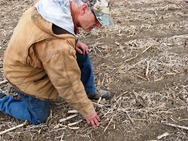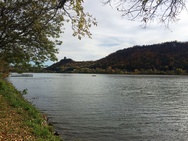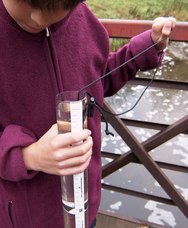|
In
1969 U.S. Sen. Gaylord Nelson of Wisconsin conceived the idea of Earth Day after witnessing the ravages of a massive oil spill in Santa Barbara, Calif., according to the Earth Day Network.
Inspired by the student anti-war movement, he marshaled forces – including a
Republican – to launch a national “teach-in” on the environment in 1970.
“As a result, on the 22nd of April, 20 million Americans
took to the streets, parks, and auditoriums to demonstrate for a healthy,
sustainable environment in massive coast-to-coast rallies. Thousands of colleges
and universities organized protests against the deterioration of the
environment. Groups that had been fighting against oil spills, polluting
factories and power plants, raw sewage, toxic dumps, pesticides, freeways, the
loss of wilderness, and the extinction of wildlife suddenly realized they
shared common values,” the website reads.
“Earth Day 1970 achieved a rare political alignment,
enlisting support from Republicans and Democrats, rich and poor, city slickers
and farmers, tycoons and labor leaders. The first Earth Day led to the creation
of the United States Environmental Protection Agency and the passage of the Clean Air, Clean Water, and Endangered Species Acts.”
The
quest to protect the environment continues today. In Minnesota’s plan to
restore and protect its waters, much of the work will fall to individual
citizens and landowners. In celebration of Earth Day this
week, this Waterfront Bulletin highlights the good work of individuals who make
every day an Earth Day.

The big ‘Halloween blizzard’ of 1991
did more than dump 30 inches of snow across much of the state. Preventing late
fall plowing, it persuaded farmer Charlie Cunningham the following spring to
unhook the plow and start using “no-till” for raising soybeans.
“The blizzard shut us down,” Charlie says.
When the spring of 1992 rolled around, he and his farming partners decided to
forgo plowing, and use a “drill” to plant soybeans directly into fields still
covered by the previous year’s corn stalks.
Charlie, his brother John, and third
partner, Cal Freeman, grow corn and soybeans rotated on 3,200 acres of gently
rolling cropland southwest of Atwater in Kandiyohi County. Their corn is
planted after field cultivating – another method of minimum tillage – in the
previous year’s soybean fields.
Today, soil experts are busy
promoting the idea that little or no plowing cropland offers many benefits. It
reduces production costs, improves soil health, reduces soil erosion and
runoff, and yet still allows good crop yields. The Food and Agriculture Organization of the United Nations has
designated 2015 as the International Year of Soil.
Cal Freeman says the crop residue
has increased their soil organic matter to nearly 6 percent. A 1 percent increase in soil organic matter can hold an
additional 75,000-100,000 gallons of water per acre. This allows it to drain
more slowly, which can help even out the erosive flow of water in streams and
rivers.
Since 1992, improvements in
equipment, fertilizers, and herbicides have made it easier, Charlie says. Along
with less time needed for field work, no-till is less expensive. “There’s
absolutely less input cost.” And their crop yields match anyone in the
neighborhood, Cal says.
|
In celebration of Earth Day, the
Minnesota Association of Soil and Water Conservation Districts emphasizes that
each of us has a connection to natural resources. Across Minnesota, Soil and Water
Conservation Districts (SWCDs) are helping people to conserve land, water,
forests, wildlife and other natural resources. The association is proud to be a
part of this locally-led, voluntary movement, serving as a resource for
landowners and farmers. Earth Day is a good day to encourage landowners to visit
with their local SWCD staff. Visit Districts on the Web to for contact information.

Minnesotans feel strongly about their
iconic lakes and are uniquely active in protecting them. Citizens around the
state are responding to water quality threats to their beloved lakes. Their
work, in some cases, has been going on for decades, and the MPCA recognizes
their critical role in defending lakes from a variety of contaminants. A few
examples:
Lake Volney — A local association
has worked for decades to improve Lake Volney in Le Sueur County, near Le
Center. They’ve taken on wetland restoration, buffer strips, stream bank
stabilization, raingardens, annual cleanups, and working with farmers to adopt
beneficial practices. The lake has gone from algae covered in the 1990s to good
water clarity in 2013.
Lake Shaokatan —Located near Ivanhoe
in Lincoln County, Lake Shaokatan is in a watershed dominated by agriculture
and has suffered from excess runoff of nutrients such as nitrogen and
phosphorus. It has extensive algae blooms in the summer — including blue-green
algae which is toxic to humans and pets — and has seen periodic fish kills. A
partnership of state and federal agencies, local governments, and local groups
began by addressing malfunctioning septic systems near the shore, runoff from
animal feedlots, and wetlands restoration. Ongoing efforts continue to bring
improvements in the lake’s water quality.
Lake Winona — A group scientists,
residents, and local officials calling themselves Healthy Lake Winona has
formed recently in order to look at ways to improve water quality in Lake Winona in southeast Minnesota (photo above).
The lake is burdened with excess phosphorus, which can cause algae growth,
reduce water clarity, and kill fish. One source of the phosphorus is stormwater
runoff that carries fertilizers, leaves, and grass clippings. The group hopes
to promote residential rain gardens that can reduce stormwater and to educate
city residents on keeping debris out of storm drains.
The Minnesota
Waters web site
has a list of and links to the state’s active network of lake associations and
rivers organizations, which are critical to protecting water quality in the
state. The sheer number of lake and river organizations demonstrates how
important our water resources are to Minnesotans.
|

Across Minnesota, more than 1,300 volunteers
help protect our water quality through the Citizen Monitoring programs. But more help is
needed.
“69,000 miles of rivers and over 12,000 lakes is a lot of water to cover,” says
Laurie Sovell, coordinator of the MPCA’s Citizen Stream Monitoring Program. “We
are looking for people curious about local water bodies and passionate about
protecting our state’s water resources.”
The Citizen Stream and Citizen Lake Monitoring Programs
offer the opportunity to participate in the long-term protection of
lakes and streams by collecting valuable information the state will use to make
decisions to maintain and improve the health of our waters.
As part of the program,
volunteers are asked to perform a short and simple water clarity test at their
favorite lake or stream, once per week throughout the summer. Equipment and
training are provided by the MPCA and no prior experience is necessary. For
some lakes and streams, volunteer-collected data is the only data available,
making citizen involvement critical to ensuring the lasting health of
Minnesota’s waters.
Find out if your favorite lake
or stream needs monitoring by using an interactive map on the agency's website.
To become a volunteer or learn
more about the program, visit the program’s citizen monitoring webpage, or
call 651-296-6300 (Twin Cities) or 1-800-657-3864 (Greater Minnesota).
|
|